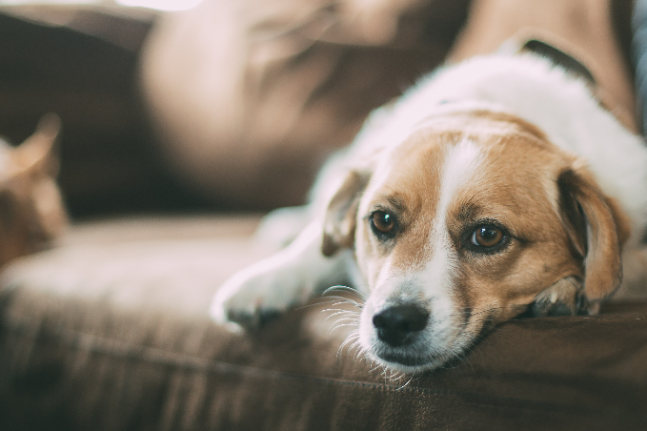Does your dog have separation anxiety?
Does your dog bark or howl all day while you are at work? Does he destroy your sofa cushions, dig holes or frequently escape? It may be that he’s exuberant and playful, with extra energy to burn, but if that’s the case then he will usually do these things whether or not you are home. What may also be happening is that your dog is stressed when left alone.
Separation anxiety occurs in dogs when they are over-attached to their owners. Dogs that have been rehomed, or shelter dogs, are more likely to feel insecure. Older dogs may show anxiety due to medical issues, so make sure they have a veterinary checkup.
Reducing this anxiety requires a combination of behaviour modification, exercise, training, strategies to encourage calm, and the use of Bach Flower remedies, nutritional supplements and herbs to help reduce anxiety.
There may be clues your dog is stressed when you are away. She may continually seek contact with you, following you from room to room. She may excessively greet you when you arrive home. Signs of anxiety such as panting, crying, shaking or pacing may become obvious when you begin the departure routine.
Over-dependence is something we have fostered over years of domestication of dogs. These days, puppies are likely to be separated from their dam and siblings at 6–8 weeks of age. We may also be selecting for breeds that are affectionate and dependent. We tend to treat dogs like children, so they remain dependent and “need” us rather than learn independence as they would in the wild.
Separation anxiety causes stress and anxiety for owners, who have to deal with the destruction, escaping and possibly irate neighbours who can’t handle the noise. It leads to rehoming and, in the worst cases, euthanasia.
Finding a cure
There is no magic cure. Reducing this anxiety requires a combination of behaviour modification, exercise, training and strategies to encourage calm, and the use of Bach Flower remedies, nutritional supplements and herbs to help reduce anxiety. There are medications that may be tried short term in the most severe cases, but these will not work without behaviour modification.
The first step is to see your vet to ensure there is no other health issue. To help with behaviour modification, they may suggest an appointment with a specialist animal behaviouralist. This may sound extreme, taking your pet to the “doggy psychiatrist”, but you will be living with your dog for many years and it’s vital for both of you that the relationship is not stressful.
I always recommend general exercise and training. If at all possible, your dog should have a long enough walk or run in the morning before you go to work to wear her out. A tired dog simply has less energy to be destructive or anxious. I also recommend daily general training. This can be done in the evenings, and is to teach your dog mental focus. Daily training sessions at home can be combined with a weekly training group activity.
To reduce over-attachment you need to teach your dog independence. One strategy is to try not to make too much fuss when you leave or return. As your dog welcomes you home with excited barking and jumping, you must try to ignore her until she has settled, then reward her calm behaviour with something she likes: a treat or a pat. You must be the one to initiate the connection. Be calm and remember, when you first start ignoring her, she will try even harder to get your attention.
Take it a step further. You may need to teach your dog to sleep on her own bed, at a distance from your own. If your dog is especially attached to you, and there are others in the household, encourage a relationship with them by having them undertake feeding, walking and training.
The second step is to create a safe and happy place for your dog to stay when you are out. Keep the talkback radio on, or classical music. Give him a positive time-consuming treat that is only used for going out, such as a Kong with frozen food, or a treat-releasing toy.
Consider using DAP (Dog Appeasing Pheromone) in a diffuser, or sprayed on a bandanna, to encourage calm. This is a synthetic chemical that mimics that secreted by a mother to her pups. It may help to provide a den or even a crate for your dog to use while you are away. This crate is only ever a good place. Perhaps feed your dog in there, and include his favourite bed.
The third step is to desensitise him to your leaving routine. You probably have a set routine before your leave every morning, so try to vary this. Also, run through some of it when you are not actually leaving. These simple steps will help some dogs, but others may need a gradual desensitising program, changing in increments as his anxiety reduces.
Separation anxiety is a common and complex behaviour in dogs as well as other pets. In some instances it’s mild and in others really stresses the relationship between pet and owner. There is no “one size fits all” solution and I have only covered a few options. Above all, use positive strategies and ask your vet for help.








